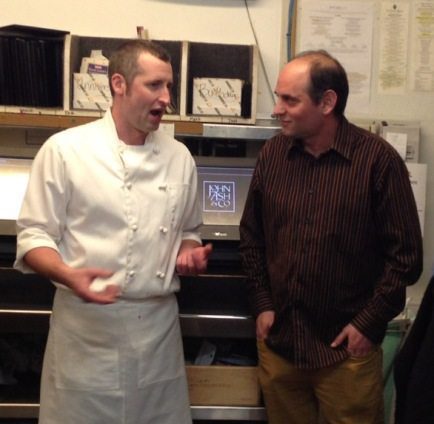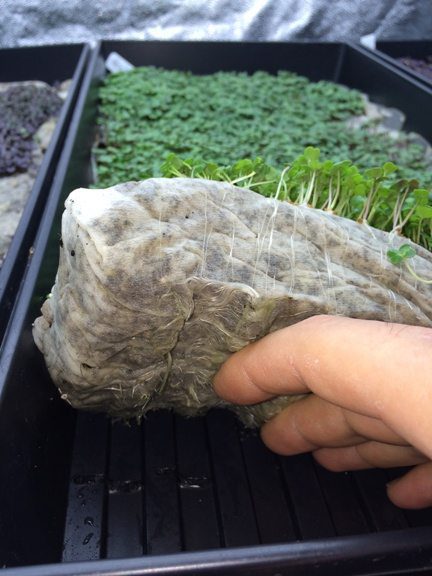This article was written by Gaby Bronstein from The Garden Sprout indoor gardening shops in Santa Rosa and Willits, California. It was originally published in Garden Culture Magazine, Issue 3 under the title, “Bringing the Farm into The Kitchen”.
Bringing the farm into the kitchen… John Ash & Co. grow microgreens indoors.
Thanks to chefs like Alice Waters and John Ash in California, the “Farm to Table” movement has seen exponential growth in restaurants across the country in recent years. The philosophy of farm to table is a simple one, based on restaurants using locally grown, seasonal ingredients on their menus. In most cases, this establishes a relationship between the restaurant and the farm. Often times, the restaurant may actually be on the same property as the farm. This blended model not only allows the chef to give input on what’s grown, but it also allows for picking the fruits and vegetables at peak ripeness and served within minutes of harvest. Foods delivered to your plate with this method not only have peak flavor, but they also have maximum nutritional value.
I find it interesting that even with the rapid growth of the Farm To Table movement, very few if any, restaurants grow their own microgreens on-site. The restaurants I spoke to buy their microgreens from local farms or farmers markets, and refrigerate them for a few days before using them. I realized this presented a unique opportunity to help restaurants to not only increase freshness and nutritional value but to also lower food costs simultaneously. Much of the cost of microgreens is the packaging, delivery, and marketing, and nothing is more nutritious pound for pound as garden-fresh microgreens.

Gaby Bronstein & Devin Kellogg, Sous Chef discussing the kitchen microgreens farm at John Ash & Co.
Following a good friend’s suggestion, I contacted some restaurants to see if they would be interested in me helping them grow microgreens on-site. I did a quick internet search where I live for “Top Restaurants Santa Rosa California.“ The number one response was John Ash & Co. PERFECT! Not only is this one of Sonoma County’s top restaurants, but the namesake, John Ash, is both the “The Father of Wine Country Cuisine,” and one of the pioneers of the Farm to Table movement.
I emailed the Executive Chef, Thomas Schmidt, with the proposal of helping them grow microgreens indoors on-site. I asked if I could deliver a sample so he could see what we could produce there. To my joy and amazement, a response to my email arrived immediately, because the chef was interested!
I made arrangements to speak with Chef Schmidt, and deliver samples later on that week. Arriving at the restaurant for our meeting, I could see he was pleasantly surprised that I brought flats of LIVE microgreens. The samples included Arugula, Red Russian Kale, Daikon and Red Rambo Radishes, Broccoli, Opal Basil, Snap Peas, 3 types of Mustards, as well as a Spicy and Mild Mix.

The vibrancy and flavor of my microgreen samples impressed Chef Schmidt, but he was a little concerned about how much space would be needed to grow enough microgreens to supply the restaurant. I explained that if we used Growlab Horticultural’s Clonelab Tall (with some shelves added) that we could grow 20 flats in an area of 2’W x 4’L x 6’H. The microgreens take 5 – 14 days to grow, and we would have no less than 10 flats a week ready for harvest. We located the perfect unused space behind a door in the staff break room. This was an empty space just a few steps away from the kitchen.
Less than one week later, the kitchen microgreens farm was up and running. To ensure the restaurant’s success, we started seeds at my indoor garden shop, The Garden Spout. I prepared the soil using a new technique I saw being used in a microgreen forum I follow. This technique involves making what I call “Soil Tacos.” We cut out a long sheet of paper towels. We place the beginning of the towel in the flat, we then add soil and finally we wrap the paper towels back over the soil and tuck it in.
This Soil Taco method serves 2 main functions. Firstly, many microgreen seeds are quite small, and when planting such fine seed they can fall into the cracks of the soil, burying them too deep for good germination rates. Secondly, and this is even more important and useful, is how clean the paper towel method is. Most microgreens can simply be plucked out of the paper towel with the roots attached, and harvested free of soil, making cleaning as simple as a quick rinse.
The seeds are sown directly on the paper towel and are then covered with a sheet of white plastic. This gives the seeds the darkness they need and protects them from drying out since they are on the surface. Without this plastic sheet, the seeds dry out very quickly unless they are misted multiple times a day. The planted flats are then placed on a heating pad and left to do their thing with nothing more than a daily misting for 3 days needed.
Now it’s time for finishing off the crop. All the seeds have germinated and started growing in that short span of time. Removing the plastic, you find many seedlings are yellow colored due to the lack of exposure to light. This green pigment deficiency is called “etiolation.“ Within a few hours of exposure to light, the microgreen seedlings green up nicely, as seen in the photo below.

The last thing I do before delivering these starts is to thoroughly water them with Earth Tonic, an ocean water concentrate with added biodynamic preparations. Besides the small amounts of compost in the soil mix, the Earth Tonic is the only plant food used. Ocean water has all the elements on earth in their most natural form. When used properly, these solutions help grow even more nutrient dense crops, which translate into stronger flavors as well.
From this point on, the restaurant staff only needs to make sure the microgreens do not dry out. We set up a simple system that allows them to water all the flats in less than 5 minutes. Making this process easy helps ensure that it is not forgotten.
Within 2 days from this point, the Chef can harvest the micro greens as needed. To serve patrons the most vibrant greens, while at the same time ensuring little to no waste, harvesting will take place as often as 3 – 4 times in a service.
In the upcoming weeks I will be training the culinary gardener at John Ash how to prepare the soil mix for the Soil Tacos, and the planting procedures, so they can become fully self-sufficient… but growing microgreens couldn’t be easier! Anyone can grow them. I would even go as far to say it’s the easiest crop of all and offers the highest possible nutritional value.
So, get a Kitchen Microgreens Farm growing for Macro results.